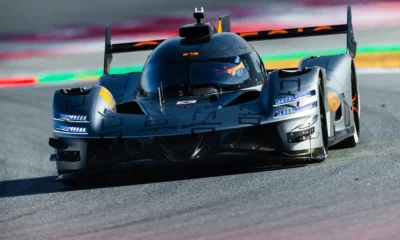
Photo: IMSA
With a P2 team having yet to claim victory in the TUDOR United SportsCar Championship, the ACO has voiced concern over the current Balance of Performance struggles in the Prototype class.
The organizers of the 24 Hours of Le Mans, along with the FIA, control the worldwide technical regulations for the LMP2 platform, which has been integrated into the TUDOR Championship with the former GRAND-AM Daytona Prototypes.
“I cannot say now that I’m happy because only DPs have won races. That means we’re maybe not in the perfect world,” ACO Sports Manager Vincent Beaumesnil told Sportscar365 last weekend at Silverstone.
“If you look at what the balance was in January and what it is now, they made a big [gain] with the P2 but… at the moment it still looks like it’s difficult for a P2 to win a race.”
IMSA has worked closely with the ACO since the merger announcement in Sept. 2012, with an effort to maintain the international link to Le Mans that was forged with the launch of the American Le Mans Series more than 15 years ago.
While the GTLM class, which runs to full ACO GTE regulations, has been a success, efforts continue in trying to achieve an optimal balance between the P2 and DP-spec machinery.
“We’re never going to match them,” IMSA’s tech chief Scot Elkins told Sportscar365. “I’ve lost count how many times I’ve said it: We’ve got apples and oranges here.
“We always knew we were never going to get them exactly right. That’s why some of the differences we have are things we can’t make huge changes to.”
In order to remain in compliance with the ACO’s regulations, P2 cars have been essentially unaltered in the TUDOR Championship, while DP cars were given a series of upgrades, which initially included roughly a 50hp increase in horsepower.
That number, according to Elkins, is likely to decrease before the next round at Mazda Raceway Laguna Seca, in what’s the latest BoP tweak to help bring the powerful DPs in line with the lightweight P2 entries.
“We knew a DP was going to be heavier, so we gave it more power,” Elkins said. “We’re trying to work around the things that we can’t really make a huge impact on now.
“There are things we’re looking at for 2015. That’s the stuff we talked about with all of the manufacturers [in a meeting] at Long Beach.
“The other thing too is that we don’t want to do things that cause people to spend a lot of money. That was the whole purpose of trying to be consistent and let people use the equipment they have.”
Elkins feels they’ve gotten the balance close, with DP and P2 lap times within three-tenths at Sebring.
But with each car excelling on different parts of a circuit, DPs have found to have the ultimate edge on long straights and while getting through traffic.
“We saw in Sebring that P2s led the race. It wasn’t so bad,” Beaumesnil said. “On one side you have a heavy car with more power, so it will be faster on the straights and the other one will be faster in the corners.
“But as long as the cars are different, it will always be the same.”
Despite a dwindling car count, with Muscle Milk Pickett Racing’s recent withdrawal and unconfirmed reports of another team considering its options, Elkins isn’t concerned about the future of the P2 platform in North America.
“I’ll be honest, I don’t know the reasons behind Muscle Milk’s decision,” Elkins said. “Everybody that I’ve talked to, the other P2 teams are very committed to what they’re doing.
“I don’t think anybody at this [stage] can point to the Adjustment of Performance between the DP and the P2 and say, ‘That’s why we’re not racing.’ I don’t think that’s the reason, honestly.
“I don’t think we’re at any kind of risk of anything happening. We’re very, very close [on the BoP]. It’s not like we’re worlds apart in terms of making these apples and oranges race together.
“I honestly think there’s still a lot of guys waiting in the wings to see how we do this and see where we end up. That will determine what happens for next year. But the guys we’ve got now are very committed.”
Beaumesnil, who has remained connected with Elkins and the IMSA technical staff almost on a daily basis, has stressed the importance of getting the P2 cars into race-winning form, in order to ensure a healthy grid of Le Mans-spec machinery.
“It’s very important for us,” Beaumesnil said. “It’s our rules. We have a team from Le Mans racing there and all the other teams we know from P2.
“We are connected [with IMSA] and are pushing hard. We have involved the manufacturers and the teams in the discussion.
“In the end, IMSA [makes] the decision. We don’t. But they have been quite helpful by listening to what we say.”


























